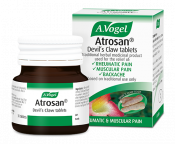How does our body repair soft tissue?
Primarily the body repairs itself through a necessary inflammatory process and an intricate physiological recovery. Generally there are thought to be three stages involved in repairing soft tissue damage; inflammation, proliferation, and remodelling.1
Inflammation involves increased movement of inflammatory chemicals to the injured area to try to clear out the damaged and dead cells caused by injury. Inflammation is necessary in the healing process, without it injuries wouldn’t heal so don’t try to eliminate it entirely!
Excessive inflammation however, can cause damage and tissue destruction which is why it’s important to manage and keep track of your injury and know whether it is chronic or not. Devil’s Claw has been traditionally used to help relieve inflammation by gently breaking the inflammatory pathways without completely blocking them.
After the inflammation stage seems to subside the second stage of the repair process, proliferation, begins. This process is essentially the formation of scar tissue, which contracts and shortens as it matures thereby reducing the site of injury. This is why careful consideration should be given to injured areas as this scar tissue can leave you feeling tighter, and tenderer in the area than you were before.
Once the scar tissue has matured and developed into stronger collagen remodelling can occur. Remodelling is critical throughout the recovery process as it aims to keep as much mobility and flexibility in the injured area to try and maintain the length of the scar tissue.
How does our body repair bones?
Healing of our bones is similar to that of soft tissues although not the same. Healing of bones requires a four stage process; reactive phase inflammation, soft callus formation, hard callus formation, and bone remodelling.
Similar to soft tissue repair, healing of bones starts with reactive inflammation which causes the fractured bone and surrounding tissue area to swell.
After this inflammation, pain and swelling have decreased soft callus formation can begin. This stage causes the area to stiffen as a result of new bone formation.
Hard callus formation covers this soft callus and bridges the fracture and builds more strength in the weakened area.
Finally, bone remodelling occurs which fixes deformities that have arisen as a result of the injury. This stage can last up to several years and involves the formation of new cartilage which merges with woven bone to form lamellar bone. Over time this then becomes trabecular bone which is nearly as strong as the original bone.
How can nutrients help?
As we have seen repairing of bones and soft tissues is a very complex process that our bodies need a lot of energy, minerals and vitamins to be able to carry out effectively. And while your diet alone is not enough to heal these types of injury, it can certainly give a helping hand in speeding up the process. So what nutrients are best to include more of?
Protein
When it comes to repairing the body protein is a must! It is the foundation of our bones, muscles, cartilage, skin and blood and is used to build and repair tissues, make enzymes, hormones and other bodily chemicals.
So protein is essential when it comes to our muscle and joint health; it makes up the majority of our tendons and ligaments and is the building block for new collagen and elastin needed for repair.
Broken down, protein is made up of amino acids – the basic building blocks for any and all structures in our body. Unfortunately, like essential fatty acids, our body is unable to make certain amino acids on its own and therefore they have to be consumed through our diet.
The process of muscle repair depends on the availability of amino acids. During the proliferation stage of the recovery process amino acids are as building blocks to help create new muscle fibre. Amino acids can enhance protein synthesis within the muscles, particularly when they are consumed with carbohydrates.2
Protein-rich foods:
• Oats
• Almonds
• Broccoli
• Chicken
• Quinoa
• Lentils

Magnesium
Magnesium acts as a nervous system and muscle relaxant, and is also responsible for helping us to fight fatigue and for regulating our mood. Magnesium is involved in over 300 chemical processes in the body including; nerve function, blood pressure regulation, bone health, hormonal interactions and the synthesis of proteins and fats.
Magnesium is also highly important for your muscles’ ability to contract and relax which makes it a great mineral to help relieve muscle cramps.
This is one important mineral! Although, sadly, it is one of the most common ones that we become deficient in despite it being widely available in our diet. Prolonged deficiency can lead to weaker bones because the body needs magnesium in order to use calcium which helps to keep bone strong.3
For more information about how you can use magnesium to help your muscles read my blog ‘Eat away your muscle pain with magnesium.’
Magnesium-rich foods:
• Spinach
• Dark chocolate
• Bananas
• Avocado
• Figs
• Pumpkin seeds

Vitamin C
When we think of vitamin C, we usually think of its super immune-boosting qualities, and while that’s certainly true vitamin C is also a key component of collagen production and ligament repair. This vitamin directly helps in the growth and repair of tissues in all parts of the body and helps the body to make collagen. It is also needed for the healing of wounds and repairing and maintaining bones and teeth.
Vitamin C is water-soluble meaning that our body can’t produce it on its own however, it is widely available in foods such as oranges and other fruits. Vitamin C helps reduce inflammation, speed up the recovery process, helps maintain cartilage and bone tissues and internally protects us from free radicals.4
Vitamin C also plays an important role in collagen synthesis as it helps to form bonds between strands of collagen fibre. If we have a vitamin C deficiency the collagen fibres formed are usually weaker meaning that we will be more prone to further injury.
Foods rich in vitamin C:
• Kiwis
• Oranges
• Papaya
• Kale

Omega-3 fatty acids
Omega-3 fatty acids help to fight inflammation and enhance collagen formation. Omega-3 fatty acids can reduce the production of molecules and substances linked to inflammation such as cytokines and inflammatory eicosanoids. Research has shown a link between higher omega-3 intake and reduced inflammation.5
Other studies have indicated that omega-3 could also help to improve bone and joint health, that an increase in omega-3s can help improve bone strength by increasing the amount of calcium in bones.6
Your body can’t make these fatty acids on its own so we have to find them through our diet. They are probably the most important nutrient when it comes to inflammation modulation, and while we need a little inflammation, a lot can be quite damaging to our body.
Omega-3 rich foods:
• Flaxseeds
• Soybeans
• Walnuts
• Wild rice
• Mackerel
• Chia seeds

Zinc
Every single tissue in our body contains zinc, so it is an important mineral when it comes to muscle healing and repair. Zinc helps to support the metabolism of proteins that your body needs to rebuild the injured area, helps to promote wound healing and reduces inflammation, stabilises protein structures and helps to regulate hormone levels. Zinc act as an antioxidant to help prevent the breakdown of cells due to free radicals.7
Zinc-rich foods:
• Chickpeas
• Cocoa powder
• Cashews
• Spinach

What else can I do to support my muscles and joints?
Your diet is one of the most fundamental ways you can look after the health of your muscles and joints (why not check out my blog for foods that can help or hurt your joint pain?) although there are some other things you can do to help;
• Don’t over, or under, exercise
Exercise is important for maintaining muscle and joint mobility and flexibility but make sure you don’t over-do it! If you exercise regularly factor in some rest days to give your body time to adjust and recover.
• Sometimes rest is best!
If you do happen to experience a muscle or joint injury sometimes rest really is best. Applying an ice pack or going for a hot bath can really help to relieve pain, find out here if heat or ice is best for your injury.
• Herbs to the rescue!
Herbal remedies are a great natural alternative to loading up on pain medication as these can often have unpleasant side effects. For muscle and joint pain I would suggest our Atrosan Devil’s Claw tablets which aim to relieve muscle and joint pain.
1 https://www.precisionnutrition.com/nutrition-for-injury-part-1
2 http://healthyeating.sfgate.com/protein-rebuild-muscle-tears-6731.html
3 https://www.activationproducts.com/blog/why-magnesium-should-be-part-of-every-athletes-recovery-process/
4 http://www.umm.edu/health/medical/altmed/supplement/vitamin-c-ascorbic-acid
5 https://www.ncbi.nlm.nih.gov/pubmed/21784145
6 https://www.ncbi.nlm.nih.gov/pubmed/9624425
7 https://www.livestrong.com/article/487452-do-zinc-supplements-help-build-muscle/









